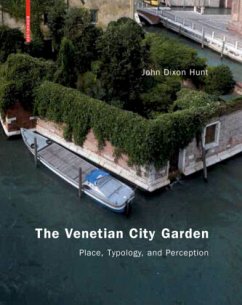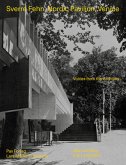No city has played a more seminal role in the development of "landscape" as a concept than has Venice. In a city where the land and gardens are reclaimed from a lagoon environment whose ecology is in jeopardy today, they are the very basis of life, dwelling, and culture. This book develops a typology of gardens distinguished by their predominantly small scale, all of which work with essential dimensions of landscape architecture: private and public space, usefulness and beauty, and open space in a densely built environment that is permeated with history.
From nearly one hundred city gardens, squares, and courtyards, public parks and temporary gardens, this book identifies garden layout and design elements that involve both material factors – spatial and design-related features – as well as the social circumstances of their use.
The areas presented include the Arsenale, where the Paradise Garden was created for the 2008 Biennale by Gustafson Porter, and the giardini and public gardens that – since their creation two hundred years ago – have served as a laboratory for making Venice into a modern city with a strong appeal to the "natural".
Für die Entwicklung von Landschaft" als Konzept hat keine Stadt eine größere Rolle gespielt als Venedig. Wo das Land und die Gärten einer heute in ihrer Ökologie gefährdeten Lagune abgewonnen werden, erweisen sie sich als Grundlage des Lebens, des Wohnens und der Kultur.
Das Buch entwickelt eine Typologie von Gärten, die sich durch den vorherrschenden kleinen Maßstab auszeichnen und wesentliche Dimensionen der Landschaftsarchitektur gestalten: privater und öffentlicher Raum, Nutzen und Schönheit, Freiraum in dichter, historisch gesättigter Bausubstanz.
Aus beinahe hundert Stadtgärten, Stadtplätzen und Höfen, öffentlichen Parks und temporären Gärten destilliert das Buch Elemente der Gartengestaltung, die sowohl die materiellen Faktoren räumliche und entwurfliche Gegebenheiten als auch die Umstände der sozialen Nutzung betreffen. Die Auswahl umfasst auch das Areal des Arsenale, auf dem der Paradise Garden von Gustafson Porter für die Biennale 2008 entstanden ist, und die Giardini und öffentlichen Gärten, die seit ihrem Entstehen vor 200 Jahren der Stadt als Labor für ihre zugleich moderne und naturnahe Entwicklung dienen.
Die Struktur der Darstellung in neun Kapiteln verbindet historische Entwicklungslinien und Freiraumtypologie. Aus der Perspektive, welchen Beitrag eine erneuerte Gartenkultur für künftige Entwicklungen leisten kann, entwirft der Autor, der seit fast 15 Jahren an der Design School der University of Pennsylvania lehrt, neue Wege in der Gartengeschichte.
Hinweis: Dieser Artikel kann nur an eine deutsche Lieferadresse ausgeliefert werden.
From nearly one hundred city gardens, squares, and courtyards, public parks and temporary gardens, this book identifies garden layout and design elements that involve both material factors – spatial and design-related features – as well as the social circumstances of their use.
The areas presented include the Arsenale, where the Paradise Garden was created for the 2008 Biennale by Gustafson Porter, and the giardini and public gardens that – since their creation two hundred years ago – have served as a laboratory for making Venice into a modern city with a strong appeal to the "natural".
Für die Entwicklung von Landschaft" als Konzept hat keine Stadt eine größere Rolle gespielt als Venedig. Wo das Land und die Gärten einer heute in ihrer Ökologie gefährdeten Lagune abgewonnen werden, erweisen sie sich als Grundlage des Lebens, des Wohnens und der Kultur.
Das Buch entwickelt eine Typologie von Gärten, die sich durch den vorherrschenden kleinen Maßstab auszeichnen und wesentliche Dimensionen der Landschaftsarchitektur gestalten: privater und öffentlicher Raum, Nutzen und Schönheit, Freiraum in dichter, historisch gesättigter Bausubstanz.
Aus beinahe hundert Stadtgärten, Stadtplätzen und Höfen, öffentlichen Parks und temporären Gärten destilliert das Buch Elemente der Gartengestaltung, die sowohl die materiellen Faktoren räumliche und entwurfliche Gegebenheiten als auch die Umstände der sozialen Nutzung betreffen. Die Auswahl umfasst auch das Areal des Arsenale, auf dem der Paradise Garden von Gustafson Porter für die Biennale 2008 entstanden ist, und die Giardini und öffentlichen Gärten, die seit ihrem Entstehen vor 200 Jahren der Stadt als Labor für ihre zugleich moderne und naturnahe Entwicklung dienen.
Die Struktur der Darstellung in neun Kapiteln verbindet historische Entwicklungslinien und Freiraumtypologie. Aus der Perspektive, welchen Beitrag eine erneuerte Gartenkultur für künftige Entwicklungen leisten kann, entwirft der Autor, der seit fast 15 Jahren an der Design School der University of Pennsylvania lehrt, neue Wege in der Gartengeschichte.
Hinweis: Dieser Artikel kann nur an eine deutsche Lieferadresse ausgeliefert werden.








